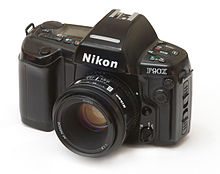Nikon F90x
 |
|
| Overview | |
|---|---|
| Type | 35 mm film single lens reflex (SLR) |
| Lens | |
| Lens mount | Nikon F-mount |
| Focusing | |
| Focus | TTL Phase Detection Autofocus (1 zone) |
| Exposure/Metering | |
| Exposure | PSAM autoexposure 3D Matrix Metering |
| Shutter | |
| Frame rate | 4.3 frame/s |
| General | |
| Dimensions | 154 x 106 x 69 mm |
| Weight | 755 g (1.664 lb) |
The Nikon F90 (known as the N90 in the United States) is a 35mm SLR camera manufactured between 1992 and 2001 and replaced the earlier Nikon F-801 (N8008 in the U.S.). At the time of its release it was noted for its fast autofocus speed compared to previous Nikon models, which had lagged behind competitor Canon's. It was thus seen by many as a 'stop-gap' measure to prevent the mass migration of many Nikon-using professional photographers to Canon, as Nikon's next fully professional camera, the F5, was some time away from release. The Nikon F4, the professional model available at the time of the F90's release, had very slow autofocus compared to Canon's autofocus SLRs.
The Nikon F90's autofocus system was driven by a small 'peanut' motor in the camera body that drove the lens via a mechanical link, unlike Canon's autofocus system, which used motors built into each lens. It was also the first Nikon SLR to interoperate with the first generation of Nikkor lenses featuring internal focusing motor.
Despite not being intended for the professional market, the Nikon F90 and its upgrade, the F90x, were built to a high standard and were (and are still) used by many professionals.
However, many F90 and F90x bodies had problems with the rubberized back, where the rubberized coating would start peeling or turn into a sticky mess. The rubber around the grip and other parts were not affected. This did not affect the functionality of the back but was a nuisance to users. The rubberised coating can however be removed (Once the door has been unclipped and safely removed from the camera body) by rubbing gently with a microfibre towel or similar soaked in plenty of Isopropyl Alcohol. This procedure will remove the rubberised top coating without affecting the surface finish of the underlying plastic or the clear film viewing window. The white printed "Vari Program" icons will remain unaffected also. The end result is a hard semi-gloss finish the same as the camera's top plate.
The Nikon F90x (known in the United States as the N90s) was a slightly upgraded version of the F90. Differences included faster and more accurate autofocus and shutter speed adjustments in thirds of a stop versus the full-stop increments of the F90. Frame rate was also increased, along with several other minor upgrades. Weather sealing was also improved. In addition, it eliminated the beeping function of the F90.
Nikon N90, F90, N90s and F90x had some accessories that improve the use of this cameras
The optional MB-10 battery grip which takes 4 AA batteries and which fits on to the base of the camera was also introduced. The MB-10 added a vertical-grip shutter release and provides a larger grip area which is especially useful when a large lens is attached to the body. The MB-10 will fully work only on the F90x and N90s models. Plain N90 and F90 models will receive and mount the MB10, but the vertical shutter controls will not work as they lack the necessary internal electrical contacts in the battery chamber. As the MB-10 operates from exactly the same 4 "AA" cells as the camera body alone, there is no increase in continuous shooting speed or AF speed as in some cameras such as the F4 / F4S. The grip is simply a convenience and handling feature. The operational speed, battery duration and frame rate of the F90X remain identical either with or without the MB-10.
...
Wikipedia
